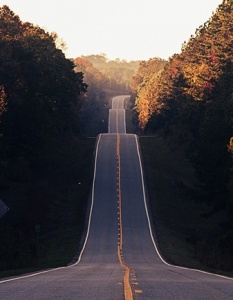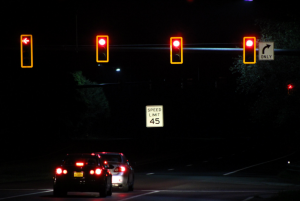
Photo by Matt Duncan on Unsplash
Does anyone else Geek out about roads and road engineering? No? Just me then.
Well, I am going to completely Geek Out about the science of road engineering for a little bit.
Roads are FREAKING COOL!
These are one of the few places where you can see incremental improvements and how much a difference they make in our lives. For example, Rumble Strips invented in 1952 – they can be rolled into newly laid pavement or cut into existing pavement (Wikipedia – Rumble Strip) – are still undergoing improvement about where they need to be put and how. There is one on my postal delivery route down the enter of the lane, on a wide curve where it is easy to drift into oncoming traffic. I have been reminded of drifting at that location more than once; and considering the paint wear, so have others.
How about the raised pavement markers (patented in 1967) and the reflective paint used on roads? The visibility at night really helps. As does edge lanes, especially on two-lane rural roads. Can you imagine not knowing where the edge of the road is? I remember when guessing the edge was a thing I had to do all the time … I love that white line of reflective paint to my right when driving down dark rural roads since its widespread addition with the turn of the century. And all the road lines – each contain a message – dashed is safe to pass, yellow means bad and white is good (Yellow on the left and white on the right means I’m traveling in the right direction, even if I can’t see any other signs). Brilliant. I’m talking about the raised pavement markers reflecting on highways on dark stormy nights. Age makes even the reflective paint lines hard to see; those plastic markers even work with astigmatism.
Does anyone else think about stormwater and roads and admire all the ways road engineering works to move the water off the impermeable surface to prevent road flooding and hydroplaning? When I started driving back in the early eighties, hydroplaning was common, but between road improvements, tire improvements, and car improvements (especially with the anti-lock brakes being added as a common safety device in the late eighties), I rarely feel loss of control.
Going into curves where the road is tilted, so you don’t have to slow down and you retain control easily is awesome. For a time, I lived on a road where the road was not tilted right. Both ways needed a sign saying “SLOW – 25 mph”; that was a true maximum speed. Drivers who didn’t heed that slow down from the 35 mph before and after the curve, ended up in my yard all the time. Having the engineers tip highways correctly makes me happy.
The slight bow in the road also is cool beans to have the stormwater divert off the road to either side, into the drains which run it to the nearest stream.
Related to water is the berms and center areas and their vegetation. Berms built up on the side of the roads decrease sound pollution when the soil and plants absorb the extra sound waves. The center areas and berms on highways not only mitigate traffic accidents, and control flooding with by providing ground with permeable surfaces, they reduce eyestrain – green and plants being kinder on the eyes than black asphalt and white concrete. The soil areas also, thanks to recent innovations of adding wildflower meadows, provide opportunities to create biodiversity for the planet. In urban settings, trees planted along roads reduce the sun hitting the streets, reducing the road heat sink as well as capturing rain water and decreasing street flooding.
Green reduces stress – scenic parkways increase relaxation. (Green Cities) My city has a parkway – green median, treelined, great berms – which runs through town about a mile south the “main street” with all the shops, malls, and doubles as a highway. Whenever I have the option of the parkway, I grab it even if the travel distance is longer. Strangely, because of the stop and go lights on the main street, the timing ends up being the same no matter which one I take.
More recent engineering designs for roads include:
- Safety edges – instead of a dropoff of pavement at the side of the road, installing a bevel making it easier to pull off the road if there is no shoulder and to get back on the road surface.
- Pedestrian Islands – when crossing multiple lanes of traffic, put an island in the median for the walkers to stop paying attention of traffic traveling one way, and start paying attention to traffic coming the other way.
- Reflective Backplates – instead of traffic signals being lights hanging against the dark, being lost in the tall building lights of an urban environment, yellow squares offset the lights from the back behind them, increasing visibility. (7 Roadway)

Image Source: https://www.pwmag.com/roadways/video-lighthawk-alpolic-350-traffic-signal-back-plate-from-korman-signs_o
All these inventions and innovations for Roads. The constant improvement. Isn’t it freaking Geeking cool?
In case you ever wonder what I think about as I drive to writing conventions.
Do you have any favorite road engineering features? Comment below.
Bibliography
“7 Roadway Engineering Design Strategies to Make Road Safer for Drivers.” Traffic Safety Store. 18 September 2018. (https://www.trafficsafetystore.com/blog/7-roadway-engineering-design-strategies-to-make-roads-safer-for-drivers/ – last viewed 11/10/2023)
Cole, Steve. “The History (Invention) of Road and Pavement Striping.” Performed Thermoplastic. 15 August 2022. (https://preformedthermoplastic.com/the-history-invention-of-road-and-pavement-striping/ – last viewed 11/10/2023)
“Green Cities: Good Health.” University of Washington. (https://depts.washington.edu/hhwb/Thm_SafeStreets.html – last viewed 11/10/2023)
Greenfield, Patrick. “Wildflower meadows to line England’s new roads in boost for biodiversity.” The Guardian. 1 December 2020. (https://www.theguardian.com/environment/2020/dec/01/wildflower-meadows-to-line-all-major-new-uk-roads-in-boost-for-biodiversity-aoe – last viewed 11/10/2023)
“The History of Anti-Lock Brakes.” Did you know cars. (https://didyouknowcars.com/history-of-anti-lock-brakes/ – last viewed 11/10/2023)
Owen, Erika. “Why the Lines on Our Roads Look the Way They Do.” Travel + Leisure. 2 August 2016. (https://www.travelandleisure.com/trip-ideas/road-trips/history-of-lines-on-roads – last viewed 11/10/2023)
Wikipedia. “Raised Pavement Marker.” (https://en.wikipedia.org/wiki/Raised_pavement_marker – last viewed 11/10/2023)
Wikipedia. “Rumble Strip.” (https://en.wikipedia.org/wiki/Rumble_strip – last viewed 11/10/2023)